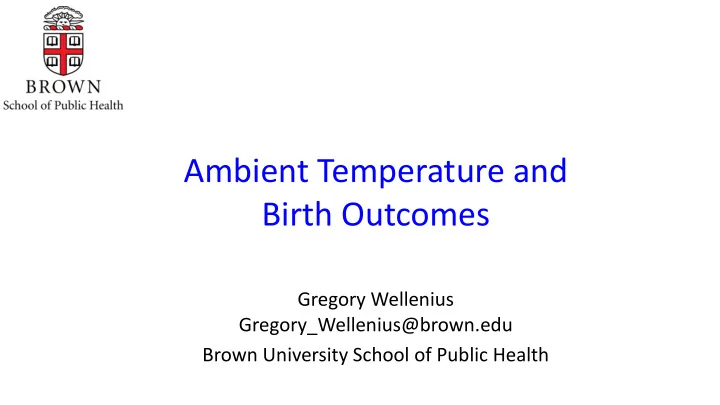

Ambient Temperature and Birth Outcomes Gregory Wellenius Gregory_Wellenius@brown.edu Brown University School of Public Health
Background • Pregnant women are sensitive to environmental exposures • Environmental exposures are important determinants of pregnancy outcomes and child health • Preterm birth – Leading cause of neonatal death and child death – Associated with higher risk of childhood morbidity • Birthweight – Marker of fetal growth – Predictive of morbidity and mortality through the life course
Background • Ambient temperature might increase risk of PTB and affect fetal growth – Smaller studies – Heterogeneous results • Objectives: – To evaluate the association between days of extreme heat or cold and risk of preterm birth – To evaluate the association between temperature throughout pregnancy and markers of fetal growth
Methods • National dataset of US births – 1989-2002 – 403 counties in contiguous US with >100,000 residents – ~32 million singleton births – Defined preterm birth as delivery <37 weeks of gestation – Defined term SGA as <10th percentile of term birthweight – Term birthweight and birthweight z- Sun et al. Environ Int. 2019 score
Methods • Temperature – Daily data from PRISM (4km) – Calculated population weighted average daily mean temperature • Analysis – PTB: Distributed lag nonlinear models – SGA: logistic regression, adjusting for age, race, marital status, education, smoking, alcohol, parity, chronic hypertension, time trends – Birthweight: linear regression with adjustment for same factors Spangler et al. JESEE. 2018
Mean Temperature and Risk of Preterm Birth Sun et al. Environ Int. 2019
Mean Temperature and Risk of Preterm Birth Sun et al. Environ Int. 2019
Mean Temperature and Risk of Preterm Birth Sun et al. Environ Int. 2019
Mean Temperature and Risk of SGA Sun et al. EHP. 2019
Mean Temperature and Risk of SGA Sun et al. EHP. 2019
Mean Temperature and Risk of SGA Sun et al. EHP. 2019
Mean Temperature and Birth Weight Sun et al. EHP. 2019
Mean Temperature and Birth Weight Sun et al. EHP. 2019
Mean Temperature and Birth Weight Sun et al. EHP. 2019
Summary • Days of extreme heat (but not extreme cold) are associated with higher risk of preterm birth • Pregnancies during warmer periods are associated with higher risk of being born small for gestational age and lower birth weight • Pregnancies during colder periods may be associated with slightly lower birthweights
Limitations and Strengths • Limitations – Data limited to more populous counties and only through 2002 – Lacking fine spatial resolution – No information on personal exposures or time-activity patterns – Date of birth is imputed from date of LMP and gestational age • Strengths – Very large sample size with information on key individual risk factors – Geographic representation across the contiguous US
Acknowledgements • Shengzhi (“Darren”) Sun • NIH grants – R21-ES023073 • Kate Weinberger – F32-ES027742 • Keith Spangler • Seed funds from the Institute at • Melissa Eliot Brown for Environment and • Joseph Braun Society (IBES) • Jeff Yanosky
Recommend
More recommend